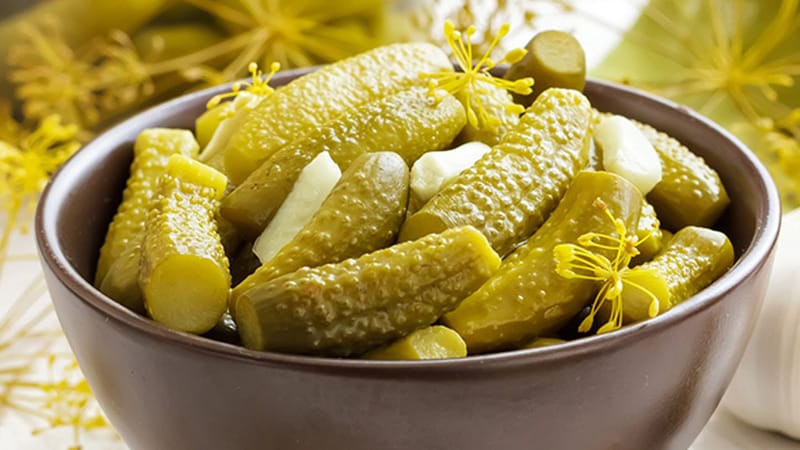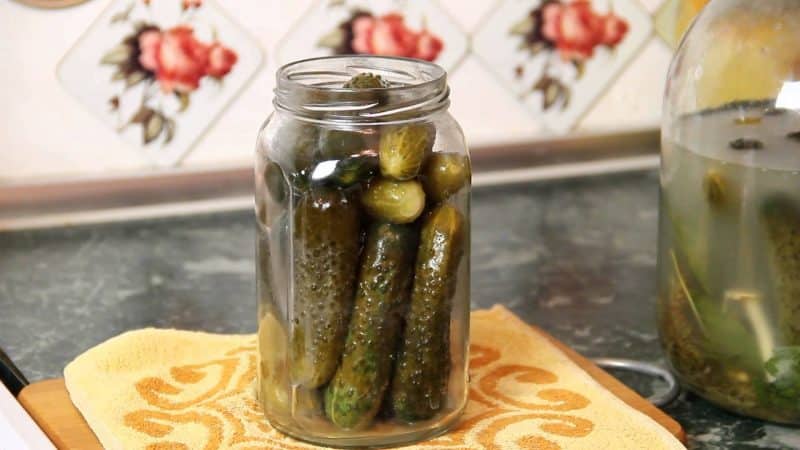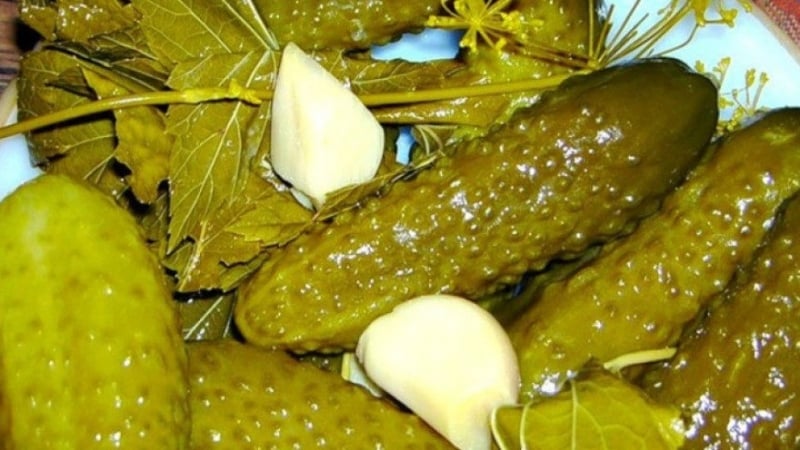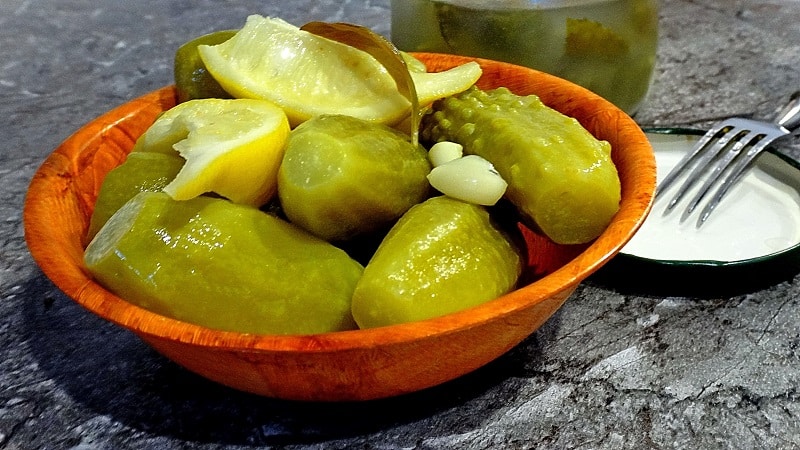How to cook pickled cucumbers at home: the most delicious recipes and useful tips
A popular appetizer and an indispensable ingredient in traditional Russian cuisine is pickled cucumbers. There are many recipes for this preparation, and today we will talk about the simplest and most popular of them.
In addition to them, in the article you will find useful tips, following which you can avoid mistakes when fermenting and spinning vegetables for the winter.
The benefits and harms of pickled cucumbers
The green vegetable contains a lot of fiber, calcium, magnesium, iron, carotene and phosphorus. It is rich in vitamins A, B, C, E, PP, H. Eating it improves immunity and rids the body of toxins. It is useful for overweight people to eat cucumbers. With their low calorie content, they create a feeling of fullness in the stomach.
Pickled vegetables are almost as healthy as fresh ones, and much healthier than pickled and salted ones due to their lactic acid content. It participates in the metabolic processes of the body. Nutritionists recommend eating them for people who want to lose weight.

Harm
Pickled cucumbers increase the acidic environment in the stomach. Therefore, it is not recommended to use them for gastritis and peptic ulcers of the stomach and duodenum.
Attention! Excessive consumption of pickled vegetables can lead to complications with existing diseases of the kidneys, heart and gastrointestinal tract.
The best pickled cucumber recipes
We have selected several recipes for making delicious, aromatic and crispy pickled cucumbers.They are fermented without the use of vinegar - lactic acid, which is formed naturally during fermentation, acts as a preservative.
Attention! The amount of ingredients in all recipes is based on one three-liter jar, unless otherwise stated.
Classic recipe in jars
Previously, the snack was fermented in an oak barrel and then stored in it. Few people have this opportunity in an apartment, so now in most cases vegetables are fermented in enamel dishes. After this, they are rolled into jars.
Ingredients:
- cucumbers – 1.3 kg;
- salt – 1.5 tbsp. l.;
- garlic – 3 cloves;
- horseradish root – 1 pc.;
- horseradish leaves – 3 pcs.;
- oak leaves – 3 pcs.;
- dill - 3 umbrellas;
- water – 1.5 l.
Preparation:
- Soak the cucumbers for half an hour in cold water. Next, rinse them well and cut off the tails.
- Place garlic, leaves and half of the chopped horseradish root on the bottom of the jar. Place vegetables vertically on top. Then the last layer is greens, remaining horseradish and leaves.
- Prepare the brine: mix water with salt and leave until it is completely dissolved.
- Pour the prepared brine over the vegetables and leave in a warm place to ferment. Do not cover with a lid.
- After three days, remove the foam. On the sixth day, pour the brine into an enamel pan and put on fire. Bring to a boil and pour back into jars.
- Sterilize the jars with the preparation in the oven (10-15 minutes) and tighten. After the snack has cooled completely, put it in the cellar or refrigerator.
Attention! You can also ferment in liter jars. To do this, divide the given amount of ingredients by three.
Cucumbers “Like barrels”
In Rus', cucumbers were fermented in barrels or tubs. The snack was popular among both nobles and peasants. If there is no barrel, vegetables can be pickle and in jars. And the following recipe will help you with this.

Ingredients:
- cucumbers – 2 kg;
- salt – 3 tbsp. l.;
- water – 1.3 l;
- black peppercorns – 8-10 pcs.;
- garlic – 4 cloves;
- dill umbrellas – 2 pcs.;
- horseradish leaf – 1-2 pcs.;
- currant leaves – 4-5 pcs.;
- cherry leaves – 5 pcs.;
- lemon acid - a pinch.
Preparation:
- Place the prepared herbs on the bottom of the jar. Add black peppercorns and chopped garlic.
- Pack the vegetables tightly into the jar. Place larger fruits on the bottom and small cucumbers on top.
- Pour 150-200 ml of water from the total amount into a separate bowl. Pour salt without a slide. Heat slightly and stir until completely dissolved. Pour in the remaining cold water.
- Fill the contents of the jar with saline solution and leave at room temperature for 3 days.
- On the third day, skim off any foam that has formed.
- On day 5-6, pour the brine into an enamel pan and bring to a boil. Boil for a couple of minutes. Remove the resulting foam with a slotted spoon.
- Pour hot brine over the contents of the jar and close the lid tightly. Turn over and leave to cool. This preparation is perfectly stored in the apartment.
Cold way
This technology for preparing snacks does not require either boiling the brine or thoroughly disinfecting the jars and then sealing them. Most housewives will appreciate this recipe.
Ingredients:
- cucumbers – 3 kg;
- salt – 3 tbsp. l.;
- red or black peppercorns - to taste;
- garlic – 4 cloves;
- horseradish leaves – 2-3 pcs.;
- currant or cherry leaves - 5-7 pcs.;
- dill - 3-4 umbrellas;
- warm water – 1 glass;
- filtered water - as needed.
Preparation:
- Rinse the cucumbers thoroughly, cut off the stems and soak in cold water for several hours.This way they will gain enough moisture and will not absorb water from the jar, thereby reducing its volume.
- Place the fruits vertically, alternating them with herbs and spices.
- Prepare the brine. To do this, pour salt into a glass of warm water and stir until completely dissolved. Pour the prepared brine over the cucumbers in the jar.
- Next, pour clean water into the jars to the very top. So that a layer of water covers the tips of the top layer of cucumbers. This will prevent fruit rotting and mold.
- Let the vegetables ferment in the brine at room temperature for 3-4 days. Then close the jars with a plastic lid and store them in a cool place for permanent storage. After 30-45 days, the cucumbers will be completely fermented and ready to eat.
Important! Store cold-cooked snacks in jars in a cool place all winter, preferably in the refrigerator.
Hot method
According to this recipe, pickled vegetables are not only beautiful and dense in appearance, but also juicy and crispy.
Ingredients:
- cucumbers – 2 kg;
- rock salt – 3 tbsp. l.;
- black peppercorns – 20 pcs.;
- bay leaf – 6-8 pcs.;
- currant leaves – 4 pcs.;
- cherry leaves – 4 pcs.;
- horseradish root – 1 pc.;
- horseradish leaves – 2 pcs.;
- dill – 6-7 inflorescences;
- garlic – 1 head;
- water – 2 l.
Preparation:
- Sterilize the jars and prepare all the ingredients. Soak the vegetables for several hours in cold water, wash the leaves, and peel the garlic.
- Place a few leaves of horseradish, currants, cherries and bay leaves in a clean, dry jar. Add 2-3 black peppercorns, a couple of cloves of garlic, 2-3 dill umbrellas and a piece of horseradish root. Fill the jar halfway with cucumbers. Then add the herbs, spices and vegetables again.Sprinkle all the seasonings on top, cover with leaves and sprinkle with salt.
- Fill all the ingredients in a jar with cold purified or boiled water.
- Place the snack in a warm place for three days. Then check: if foam appears in the jar with the preparation and the brine becomes cloudy, then the fermentation process is complete. After this, wait 6-8 hours until the foam subsides and drain the brine.
- Then strain the resulting brine and pour it into the pan. Stir and boil over medium heat for 2-3 minutes.
- Pour hot brine over the pickled vegetables. Cover with a lid and leave for 10 minutes. Then, repeat the procedure again: drain the brine, boil it again and pour it back into the jar.
- Close the jar with the workpiece with a lid, turn it over and leave to cool.
- Place the cooled snack in a cool place.

Pickled cucumbers for the winter without sterilization
Ingredients:
- cucumbers – 1.5 kg;
- cherry leaves – 20 pcs.;
- salt – 3 tbsp. l.;
- garlic – 5 cloves;
- oak or horseradish leaves – 4-6 pcs.;
- dill – 5-6 inflorescences;
- water – 2 l.
Cooking method:
- Pour cold water over the fruits and leave for 3-4 hours, or overnight. Then drain the water and rinse them well.
- Prepare the brine.
- Cut the peeled garlic into large slices.
- Place washed horseradish, oak, cherry leaves and dill umbrellas into the container. Place the fruits on top and fill with brine. Place pressure on top and leave to ferment at room temperature. This will take three to seven days, depending on the room temperature.
- Then place the fermented cucumbers in a bowl. Pour the strained brine into a saucepan, place on the stove and bring to a boil. Cool the liquid.
- Transfer the snacks to a jar or other container in which you will store them. Pour in cooled brine.
- Seal the pickled cucumbers with a plastic lid and place in the refrigerator.
Pickled cucumbers in jars with an iron lid
Many housewives roll up their preparations for the winter under the iron lid.
Ingredients:
- cucumbers – 4 kg;
- salt – 6 tbsp. l.;
- water – 3 l;
- dill - inflorescence;
- garlic – 2 heads;
- fennel;
- currant and horseradish leaves – 4 pcs.
Preparation:
- Rinse the cucumbers thoroughly; the tails can be removed or left.
- Soak the fruits in cold water for 4 hours. Then rinse again.
- Place the cucumbers in an enamel pan (basin or bucket), sprinkle with peeled garlic cloves. Place currant and horseradish leaves on top.
- Prepare the brine: add water to the salt, stir and leave until completely dissolved.
- Pour the prepared brine over the cucumbers. Place the workpiece under the press. Cucumbers are fermented in a warm place for five days.
- Place the pickled cucumbers in sterilized jars. Strain the brine, bring to a boil and pour over the vegetables. After 10 minutes, drain the brine and bring to a boil again. Then pour in the cucumbers and roll under the iron lids.
- Turn the jars upside down and cover them with a blanket. Leave in a warm place for a day.
Under nylon
To prepare crispy pickled cucumbers in jars, prepare a three-liter jar and a double-sided nylon lid.
Ingredients:
- fresh cucumbers – 2 kg;
- salt – 2-3 tbsp. l.;
- oak leaves – 5-7 pcs.;
- cherry leaves – 10-15 pcs.;
- currant leaves – 5-6 pcs.;
- garlic – 2 heads;
- dill – 5-6 inflorescences;
- horseradish leaves – 2-3 pcs.;
- horseradish root – 1 piece;
- purified water – 1.5-2 l.
Preparation:
- Prepare the brine. Prepare your ingredients. It is not necessary to sterilize the jar - the main thing is that it is clean and dry.
- Lay out the vegetables, alternating them with spices and leaves.Cover with horseradish leaves, dill and cold brine on top.
- Close the jar with a clean nylon lid.
Advice. To prevent the workpiece from becoming moldy, it is not necessary to add mustard to the brine - just lubricate the lid with it from the inside.
In a barrel
The most delicious cucumbers are pickled in a barrel. If possible, be sure to try the following recipe. In it, all ingredients are given in grams due to large volumes.

Ingredients:
- cucumbers – 50 kg;
- salt – 550 – 600 g;
- horseradish leaves – 300 g;
- currant leaves – 300 g;
- horseradish root – 200 g;
- garlic – 250 g;
- hot pepper – 5 pods;
- tarragon – 200 g;
- dill – 300 g;
- filtered water – 10 l.
Preparation:
- Prepare the brine in the evening: heat the water to 20-25 °C, add salt and stir. If it turns out cloudy, strain through cheesecloth.
- Immerse the fruits in cold water and leave for 3-4 hours to make them firmer.
- Rub the inside of the barrel well. This will prevent mold from appearing during the fermentation process. Wash and dry the currant and horseradish leaves.
- Place the prepared leaves on the bottom of the barrel and begin laying out the vegetables, alternating them with herbs. Place the fruits tightly and in an upright position. This way they will turn out denser and more beautiful.
- Pour in the saline solution, cover with a wooden lid and place pressure (place a jar of water or other weight on an inverted lid or plate).
- After 3 days, intensive fermentation will begin. At this stage, remove the foam that has formed on top and add the remaining brine.
- Place the barrel with the snack in a dark, cool place.
If the temperature conditions for storage in a barrel are observed, vegetables will be stored all winter and will not lose their taste.
Why pickled cucumbers become soft
It happens that I cooked according to a recipe, but the appetizer still didn’t work out. If, upon opening a jar of cucumbers, you find that they have become soft, do not rush to blame yourself. There are many reasons why this happened.
Most often, the following factors are to blame:
- The seal was broken and air entered the container, and with it foreign microorganisms.
- The jars, lids, or ingredients themselves were not washed thoroughly enough before sealing.
- Large container volume.
- The brine preparation technology is broken, namely, there is not enough salt in it. And the larger the fruit, the more concentrated the saline solution is made.
- Incorrect ratio of brine and cucumbers in the container. This happens when the fruit is not packed tightly enough.
- Unsuitable fruits were used for harvesting.
- Storage conditions violated. At room temperature, especially with heating radiators running, the workpiece will deteriorate within a month.
Adviсe
To ensure that the cucumbers are firm and crispy, follow the canning rules. There are few of them, and they are quite simple:
- Properly selected cucumbers are half the success. Ideal for harvesting will be fruits collected from the second half of July until the end of the first ten days of August. Early varieties and greenhouse vegetables are not suitable for these purposes - it is better to leave them for salads. The fruit size for canning is small or medium with a small seed chamber. The pulp must be dense, elastic, with a sugar content of at least 2%. The Rodnichok variety is ideal.
- If possible, select fruits collected within 24 hours for canning.
- Wash the containers for preservation as thoroughly as the fruits themselves.
- It is better to take coarse rock salt. With sea or iodized cucumbers, they will not be elastic enough.Salt to water ratio: 2 tbsp. l. salt per 1 liter of water (for large cucumbers - 2.5 tablespoons per 1 liter of water).
- Use purified and boiled water for brine. Tap water is hard and spoils the taste of the fermented snack.
- You can safely add more spices than indicated in the recipe (with the exception of dill) - this will add piquancy to the appetizer. Horseradish, cherry and currant leaves make cucumbers more elastic. Garlic has bactericidal properties and inhibits the development of harmful microflora. Prepare spices immediately before canning. When herbs wither, they lose a lot of their beneficial properties and aroma.
- Make sure that the lids fit tightly around the neck of the jar - complete tightness is required if you want the snack not to spoil for a long time.
- The optimal storage temperature for preservation is from 0 to +3 °C. In such conditions, the twists will definitely last at least six months.
Is it possible to ferment overgrown cucumbers?
Do not rush to throw away large, overripe and already yellowed cucumbers. Yes, they are not suitable for a classic snack, but they make an excellent preparation for making pickle. You will find her recipe below.
Experienced housewives ferment large fruits for subsequent preparation of cucumber snacks in their own juice. To do this, they are cut into slices or grated on a coarse grater. Then they are laid in layers, alternating with whole medium-sized fruits and sprinkled with spices, salt and sugar. To extend shelf life, add a little vinegar at the end. The workpiece is placed under a press for two days. Store the snack in a cellar or other cool place.
Pickled cucumbers for pickle
- cucumbers – 1 kg;
- dill (greens and umbrellas) – 50 g;
- tarragon – 30 g;
- black currant leaf – 30 g;
- cherry leaf – 30 g;
- salt – 70 g;
- water – 1 l.
Preparation:
- Prick thoroughly washed fruits with a fork. Place cucumbers in a fermentation bowl, alternating layers with herbs and spices.
- Dissolve the salt in water, boil it and pour the boiling salt solution over the workpiece.
- Place the vegetables under a press at room temperature for two weeks.
- Remove the fermented fruits from the brine, remove skin and seeds.
- Cut the cucumbers into cubes or strips and place in a saucepan with strained brine. Bring to a boil and simmer for ten minutes.
- Roll the hot preparation into sterile jars.
Conclusion
Now you know how to ferment cucumbers for the winter. The most important thing is to use high-quality fruits and other ingredients. The fermentation process occurs naturally without the addition of vinegar and sterilization, which greatly simplifies the preparation of the snack. Everything will take no more than 20-30 minutes.
Crispy pickled cucumbers are delicious on their own, go well with main courses, and they are also an integral part of vinaigrette, rassolnik and Olivier salad. If the recipe and storage conditions are followed, the snack, closed in the fall, will not spoil until the summer. But most likely, they will eat it much earlier!